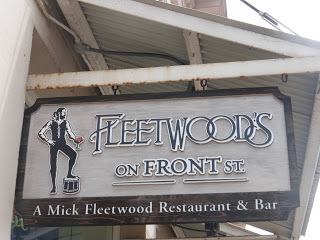Martin Edwards's Blog, page 145
April 7, 2017
Forgotten Book - Inspector French and the Starvel Tragedy
Freeman Wills Crofts published Inspector French and the Starvel Tragedy (aka The Starvel Hollow Tragedy) in 1927. It's often cited as one of his best books, and I concur with that view. The story is readable from start to finish, and the plot is worked out rather cleverly. So although I latched on to one aspect of the solution at an early stage, Crofts managed to confuse me with some rather neat twists.
At first, the focus is on an attractive young woman who lives with her miserly uncle in a Yorkshire mansion - the location seemed from internal evidence to be somewhere in the vicinity of Helmsby and Thirsk. After she goes away on a short visit to a friend, she returns to find the house burned to the ground. Three corpses are discovered, evidently those of her uncle and two servants. At first it looks like a tragic accident.
But a local bank manager takes a different view, and before long Scotland Yard are called in, in the person of good old Inspector Joseph French. He's portrayed in a rather human fashion, yearning for promotion and keen to keep on the right side of his superiors, but utterly relentless in his pursuit of the guilty once it becomes clear that this is a case of arson and multiple murder.
As with The Cask, Crofts manages to sustain interest in the detailed police investigation by offering a sequence of surprising developments. I enjoyed this book - which was reissued by Hogarth back in the 80s - and can recommend it to anyone who likes Croftsian writing. Crofts was an engineer by profession and this mystery is certainly engineered with high calibre craftsmanship.
At first, the focus is on an attractive young woman who lives with her miserly uncle in a Yorkshire mansion - the location seemed from internal evidence to be somewhere in the vicinity of Helmsby and Thirsk. After she goes away on a short visit to a friend, she returns to find the house burned to the ground. Three corpses are discovered, evidently those of her uncle and two servants. At first it looks like a tragic accident.
But a local bank manager takes a different view, and before long Scotland Yard are called in, in the person of good old Inspector Joseph French. He's portrayed in a rather human fashion, yearning for promotion and keen to keep on the right side of his superiors, but utterly relentless in his pursuit of the guilty once it becomes clear that this is a case of arson and multiple murder.
As with The Cask, Crofts manages to sustain interest in the detailed police investigation by offering a sequence of surprising developments. I enjoyed this book - which was reissued by Hogarth back in the 80s - and can recommend it to anyone who likes Croftsian writing. Crofts was an engineer by profession and this mystery is certainly engineered with high calibre craftsmanship.
Published on April 07, 2017 04:30
April 6, 2017
San Francisco

 Because Hawaii is so far away from Cheshire, I wanted to break up the long journey home. And where better to do so than a city I've long wanted to discover, San Francisco? The city by the bay did more than live up to expectations. It's now my favourite American city. I may not quite have left my heart there, but I found it quite enthralling.
Because Hawaii is so far away from Cheshire, I wanted to break up the long journey home. And where better to do so than a city I've long wanted to discover, San Francisco? The city by the bay did more than live up to expectations. It's now my favourite American city. I may not quite have left my heart there, but I found it quite enthralling.[image error]

 It's a city with strong crime fiction associations. Laurie R. King lives there, and she gave me a few tips about places to visit. I was fascinated by my first glimpse of Alcatraz, scene of some notable movies. I suppose, though, that I associate San Francisco most closely with two films. First, Bullitt, the private eye film legendary for its car chase. And second, Vertigo, one of the best crime films ever made; I've seen it four or five times. And of course the full list of famous films set there is lengthy.
It's a city with strong crime fiction associations. Laurie R. King lives there, and she gave me a few tips about places to visit. I was fascinated by my first glimpse of Alcatraz, scene of some notable movies. I suppose, though, that I associate San Francisco most closely with two films. First, Bullitt, the private eye film legendary for its car chase. And second, Vertigo, one of the best crime films ever made; I've seen it four or five times. And of course the full list of famous films set there is lengthy.

 I'm often teased for my unashamedly touristy devotion to hop-on, hop-off buses, but I'm unrepentant: they make a very good way to get one's bearings in an unfamiliar place, and my first aim was to do just that. After riding around the city, the next step was to explore Fisherman's Wharf, and Pier 39 (I hadn't expected to see large numbers of sea lions right next to it) and take a ride on one of the famous cable cars, which I loved. Then there was a night bus tour, a chance to see both the Golden Gate Bridge and the Bay Bridge lit up against the night sky. All very memorable.
I'm often teased for my unashamedly touristy devotion to hop-on, hop-off buses, but I'm unrepentant: they make a very good way to get one's bearings in an unfamiliar place, and my first aim was to do just that. After riding around the city, the next step was to explore Fisherman's Wharf, and Pier 39 (I hadn't expected to see large numbers of sea lions right next to it) and take a ride on one of the famous cable cars, which I loved. Then there was a night bus tour, a chance to see both the Golden Gate Bridge and the Bay Bridge lit up against the night sky. All very memorable.


 Next came a trip to Sausalito, an appealing little town with a Riviera-like atmosphere. From there we took the ferry across the bay, past the Golden Gate Bridge, past Alcatraz and back to the ferry terminal. And in the terminal building, while having a snack, I spotted a bookshop called Book Passage. Unable to resist, I had a look inside and to my amazement found two of the anthologies I've edited for the British Library. Quite a treat.
Next came a trip to Sausalito, an appealing little town with a Riviera-like atmosphere. From there we took the ferry across the bay, past the Golden Gate Bridge, past Alcatraz and back to the ferry terminal. And in the terminal building, while having a snack, I spotted a bookshop called Book Passage. Unable to resist, I had a look inside and to my amazement found two of the anthologies I've edited for the British Library. Quite a treat.
 Further exploration followed - the "Crookedest Street", which is unlike anything I've ever seen - Chinatown, Japantown, and the Painted Ladies (the latter a group of houses on Alamo Square). My plan now is to read some more crime fiction set in San Francisco. I'm familiar with Laurie's books - any other recommendations?.
Further exploration followed - the "Crookedest Street", which is unlike anything I've ever seen - Chinatown, Japantown, and the Painted Ladies (the latter a group of houses on Alamo Square). My plan now is to read some more crime fiction set in San Francisco. I'm familiar with Laurie's books - any other recommendations?.

[image error]
Published on April 06, 2017 03:21
April 5, 2017
Hawaii Five-O


 My trip to Hawaii was replete with crime story connections. Quite apart from Charlie Chan, I cast my mind back to two shows I watched as a small boy - Hawaiian Eye, and Hawaii Five-O. One tour on Oahu even gave me a sight of the island used as setting for another show I enjoyed when very young - Gilligan's Island. I doubt it would stand up to scrutiny now. And though I didn't bump into Steve McGarrett, I was delighted to share the adventure with Steve Steinbock. There were many conversations about crime fiction late into the evening.
My trip to Hawaii was replete with crime story connections. Quite apart from Charlie Chan, I cast my mind back to two shows I watched as a small boy - Hawaiian Eye, and Hawaii Five-O. One tour on Oahu even gave me a sight of the island used as setting for another show I enjoyed when very young - Gilligan's Island. I doubt it would stand up to scrutiny now. And though I didn't bump into Steve McGarrett, I was delighted to share the adventure with Steve Steinbock. There were many conversations about crime fiction late into the evening.


 After Oahu, we went to Kauai, where Steve hired a car, enabling us to cover much of the island, including a canyon described as the island's answer to the Grand Canyon. Quite a spectacle. Kauai really is a tropical paradise, and I have come up with an idea for a story set there. I'm hoping to start work on it shortly. I'm no wildlife expert, but Hawaii is full of fantastic opportunities to see the indigenous wildlife. We saw everything from giant turtles swimming off the amazing Spouting Horn on Kauai, to wild pigs at a waterfall a few miles from Lihue, mongooses aplenty on Oahu, and roosters everywhere.
After Oahu, we went to Kauai, where Steve hired a car, enabling us to cover much of the island, including a canyon described as the island's answer to the Grand Canyon. Quite a spectacle. Kauai really is a tropical paradise, and I have come up with an idea for a story set there. I'm hoping to start work on it shortly. I'm no wildlife expert, but Hawaii is full of fantastic opportunities to see the indigenous wildlife. We saw everything from giant turtles swimming off the amazing Spouting Horn on Kauai, to wild pigs at a waterfall a few miles from Lihue, mongooses aplenty on Oahu, and roosters everywhere.


 Next stop was Maui, and we stayed at Lahaina, where Mick Fleetwood has a restaurant on Front Street, a road awash with galleries selling very impressive and very expensive art ("Is thirteen thousand dollars a lot of money? I don't know," one gallery owner mused; I did know, and made my excuses quickly enough.)
Next stop was Maui, and we stayed at Lahaina, where Mick Fleetwood has a restaurant on Front Street, a road awash with galleries selling very impressive and very expensive art ("Is thirteen thousand dollars a lot of money? I don't know," one gallery owner mused; I did know, and made my excuses quickly enough.)

There were hula dancers aplenty, but the most memorable sights came when we went whale watching on an eco-ferry. I once went dolphin watching off Gibraltar, and saw not one dolphin, but this was very different. The sea was full of whales, and it was fascinating to watch them. I found myself intrigued by the Hawaiian way of life, as well as by the wonderful scenery. A memorable trip, for sure.



Published on April 05, 2017 03:53
April 3, 2017
Honolulu Havoc Left Coast Crime in Hawaii
 Right now, I am adjusting (rather slowly) to British Summer Time after a trip which took me to the other side of the world. The jetlag was definitely worth it - I had an amazing time, and feel fortunate to have spent just over a fortnight globe-trotting after my previous travels in recent weeks. The reason for this jaunt was that the Left Coast Crime convention, which I've attended once before, in Seattle, was being held in Hawaii this year. I felt that Honolulu Havoc presented a once-in-a-lifetime chance, so I grabbed it.
Right now, I am adjusting (rather slowly) to British Summer Time after a trip which took me to the other side of the world. The jetlag was definitely worth it - I had an amazing time, and feel fortunate to have spent just over a fortnight globe-trotting after my previous travels in recent weeks. The reason for this jaunt was that the Left Coast Crime convention, which I've attended once before, in Seattle, was being held in Hawaii this year. I felt that Honolulu Havoc presented a once-in-a-lifetime chance, so I grabbed it. The convention was fun. I moderated one panel, on the theme of criminal justice, with four American panellists whom I hadn't met before but, who to my delight, proved to have plenty of great stories to tell. And I took part in a Golden Age panel, very well moderated, with colleagues including Ragnar Jonasson and Steve Steinbock. This was tremendous fun, with a very good crowd. It seems almost incredible, but in the last six months I've talked about Golden Age mysteries in New Orleans, Madrid, Dubai, and Hawaii.
The convention was fun. I moderated one panel, on the theme of criminal justice, with four American panellists whom I hadn't met before but, who to my delight, proved to have plenty of great stories to tell. And I took part in a Golden Age panel, very well moderated, with colleagues including Ragnar Jonasson and Steve Steinbock. This was tremendous fun, with a very good crowd. It seems almost incredible, but in the last six months I've talked about Golden Age mysteries in New Orleans, Madrid, Dubai, and Hawaii. There was also the chance to catch up with a range of old friends, including my delightful American publishers, Rob Rosenwald and Barbara Peters, who were in grand form. As I've said before, the social side is what makes conventions, in my opinion, so well worth the time, effort, and cost. As friendships grow, and mutual understanding develops, opportunities for worthwhile writing and other projects can sometimes emerge, and this is often very exciting. I enjoyed meals with my publishers, with Laurie R. King, Bill and Toby Gottfried, uber-Sherlockian Les Klinger, among others. I was also glad to have a chat with Jonathan and Faye Kellerman, whom I hadn't met before, and another guest of honour, Colin Cotterill. Steve and his wife had agreed with us that we'd share each other's company on three Hawaiian islands, and this worked out wonderfully well. One of our dinners even took place in a restaurant named in tribute to Charlie Chan.
There was also the chance to catch up with a range of old friends, including my delightful American publishers, Rob Rosenwald and Barbara Peters, who were in grand form. As I've said before, the social side is what makes conventions, in my opinion, so well worth the time, effort, and cost. As friendships grow, and mutual understanding develops, opportunities for worthwhile writing and other projects can sometimes emerge, and this is often very exciting. I enjoyed meals with my publishers, with Laurie R. King, Bill and Toby Gottfried, uber-Sherlockian Les Klinger, among others. I was also glad to have a chat with Jonathan and Faye Kellerman, whom I hadn't met before, and another guest of honour, Colin Cotterill. Steve and his wife had agreed with us that we'd share each other's company on three Hawaiian islands, and this worked out wonderfully well. One of our dinners even took place in a restaurant named in tribute to Charlie Chan.

Honolulu is on Oahu, and it's a busy place, overflowing with tourists, but beyond the skyscrapers and the beaches there is also a lot of history. I learned much more about the tragic events at Pearl Harbour, and also went on a trip round the south part of the island, After four days, I was sorry to leave. So will I be writing a story set in Oahu? I doubt it. But Kauai, our next destination, was a different story...
,
Published on April 03, 2017 03:29
March 31, 2017
Forgotten Book - The Murder on the Burrows
My Forgotten Book for today is The Murder on the Burrows, which in 1931 launched the long and pretty successful career of E.C.R. Lorac. For a debut novel from the Golden Age, it stands up to present day scrutiny rather well, There are a few awkwardnesses about the writing, admittedly. For instance, I think she confuses the ranks of superintendent and sergeant. What's more, the chap who was to become her series cop, Inspector Macdonald (sometimes called Chief Inspector in the story) is given the first name James, although he became Robert in later books.
Overall, though, the story is a good one, and it gets off to a swift start when two men discover an apparently abandoned motor car on the Burrows at Bideford Bay. (This area was a favourite holiday spot for the author). The car proves to contain a dead body inside it, though it soon becomes apparent that the crime was committed elsewhere.
When Scotland Yard is called in, Macdonald focueses his inquiries in London. The dead man had a Russian name, but in reality he was an Englishman who had become a Communist. Lorac does not dwell on the political aspects of the story, but the deceased is treated rather sympathetically. My impression is that her politics were, at least at this point in her life, left of centre, though I doubt she was one of those Golden Age writers who flirted with Marxism. But there's a liberal flavour to her work in the 30s.
Lorac was keen on music, and this is evident when a classical pianist enters the story. Macdonald is roughly in the Inspector French tradition of persistent, if likeable cop, though the fictional detectives who are name-checked are Poirot and Lynn Brock's Colonel Gore (who at that time was much better known than he is today). Macdonald needs to return to the Burrows to resolve matters, and all in all the story is neatly constructed. If you could find a first edition of this rare novel in a dust jacket, it would be worth a great deal of money. Lorac has been a collectible writer for some time, and this is a rare title. But I'm glad I managed at least to track down a second hand reprint.
Overall, though, the story is a good one, and it gets off to a swift start when two men discover an apparently abandoned motor car on the Burrows at Bideford Bay. (This area was a favourite holiday spot for the author). The car proves to contain a dead body inside it, though it soon becomes apparent that the crime was committed elsewhere.
When Scotland Yard is called in, Macdonald focueses his inquiries in London. The dead man had a Russian name, but in reality he was an Englishman who had become a Communist. Lorac does not dwell on the political aspects of the story, but the deceased is treated rather sympathetically. My impression is that her politics were, at least at this point in her life, left of centre, though I doubt she was one of those Golden Age writers who flirted with Marxism. But there's a liberal flavour to her work in the 30s.
Lorac was keen on music, and this is evident when a classical pianist enters the story. Macdonald is roughly in the Inspector French tradition of persistent, if likeable cop, though the fictional detectives who are name-checked are Poirot and Lynn Brock's Colonel Gore (who at that time was much better known than he is today). Macdonald needs to return to the Burrows to resolve matters, and all in all the story is neatly constructed. If you could find a first edition of this rare novel in a dust jacket, it would be worth a great deal of money. Lorac has been a collectible writer for some time, and this is a rare title. But I'm glad I managed at least to track down a second hand reprint.
Published on March 31, 2017 03:00
March 29, 2017
Final Appointment - 1954 film review
Final Appointment is a good example of the Fifties black and white crime movie. Short and snappy and appealing, with a bonus in the appearance of a future star. This is a story about a series of killings that are clearly connected. A journalist (played by John Bentley) investigates, in collaboration with a colleague who fancies him (Eleanor Summerfiled) and an affable if sceptical cop (Liam Redmond).
The film begins with Bentley waiting for an appointment with a snooty solicitor (Hubert Gregg). He's told brusquely that you can't walk in off the street and demand an appointment with the senior partner. Nowadays, of course, you'd have to spend ages proving your identity so that there could be full compliance with anti-money laundering legislation. No such bureaucracy sixty years back...
Bentley has discovered that three men have been killed on the same date in each of the past three years. And that the solicitor is receiving threatening letters. Bizarrely, the solicitor doesn't seem in the least bit bothered. There's not a strong plot reason for this remarkable lack of legal caution. Soon the connecting link between the deaths becomes clear. I felt this revelation might have been held back a bit to increase the mystery. I was also not quite convinced that the motive was strong enough to justify such havoc. Anyway, for most of the film, the focus is on identifying the killer, and trying to avert the murder of the irritating solicitor..
The cast is a good one, and includes that versatile actor Sam Kydd. But I was particularly pleased to spot Arthur Lowe working in the solicitors' office. Yes, Captain Mainwaring himself, looking exactly the same as he did many years later. It's a small part, though; he was a minor figure in those days. Overall, it's a film well worth watching, directed by Terence Fisher with a screenplay by Kenneth Hayles. The source was a play by Sidney Nelson and Maurice Harrison called Death Keeps a Date.
The film begins with Bentley waiting for an appointment with a snooty solicitor (Hubert Gregg). He's told brusquely that you can't walk in off the street and demand an appointment with the senior partner. Nowadays, of course, you'd have to spend ages proving your identity so that there could be full compliance with anti-money laundering legislation. No such bureaucracy sixty years back...
Bentley has discovered that three men have been killed on the same date in each of the past three years. And that the solicitor is receiving threatening letters. Bizarrely, the solicitor doesn't seem in the least bit bothered. There's not a strong plot reason for this remarkable lack of legal caution. Soon the connecting link between the deaths becomes clear. I felt this revelation might have been held back a bit to increase the mystery. I was also not quite convinced that the motive was strong enough to justify such havoc. Anyway, for most of the film, the focus is on identifying the killer, and trying to avert the murder of the irritating solicitor..
The cast is a good one, and includes that versatile actor Sam Kydd. But I was particularly pleased to spot Arthur Lowe working in the solicitors' office. Yes, Captain Mainwaring himself, looking exactly the same as he did many years later. It's a small part, though; he was a minor figure in those days. Overall, it's a film well worth watching, directed by Terence Fisher with a screenplay by Kenneth Hayles. The source was a play by Sidney Nelson and Maurice Harrison called Death Keeps a Date.
Published on March 29, 2017 14:51
March 27, 2017
Death Goes to School - 1953 film review
I was intrigued to find Death Goes to School , a 1953 black and white movie, on the Talking Pictures schedule recently. Public schools were a rather popular setting for traditional mysteries. Nicholas Blake, R.C. Woodthorpe, Christopher Bush, Gladys Mitchell and others wrote good examples, using the "closed society" of the English public school to provide a conveniently limited pool of suspects. But I'd never heard before of this film, or the novel on which it was based, Death in Seven Hours by Stratford Davis.
I discovered that Stratford Davis was a pen-name for Maisie Sharman, who also co-wrote the screenplay with the film's director, Stephen Clarkson. I know little about Sharman, but it seems she enjoyed a remarkably lengthy, if not exactly prolific, career as a screenwriter. According to that useful source IMDB, her first credit was a 1938 film called Night Journey, and her last was a 1973 TV mystery, written as Miriam Sharman. If anyone reading this blog is familiar with her work, I'd like to know more.
Death Goes to School is an unpretentious mystery, but competent and still watchable. It benefits from the fact that three key roles went to actors of genuine quality. Barbara Murray plays the likeable young schoolteacher whose scarf is used to strangle a nasty colleague. Gordon Jackson plays the rather macho police inspector and the ever-reliable Sam Kydd is his sidekick. They get the best out of their parts. There's quite a nice joke when Barbara Murray gives as her alibi the fact that she was reading a thriller called...Death in Seven Hours.
The plot is competent rather than dazzling. Various people at the school have a motive, as the thinly characterised victim really was very unpleasant. Someone outside the school then comes into the frame. I felt that the motive for the murder wasn't terribly convincing, but despite this weakness, the film held my attention. As with so many of those Fifties B-movies, it's decent light entertainment.
I discovered that Stratford Davis was a pen-name for Maisie Sharman, who also co-wrote the screenplay with the film's director, Stephen Clarkson. I know little about Sharman, but it seems she enjoyed a remarkably lengthy, if not exactly prolific, career as a screenwriter. According to that useful source IMDB, her first credit was a 1938 film called Night Journey, and her last was a 1973 TV mystery, written as Miriam Sharman. If anyone reading this blog is familiar with her work, I'd like to know more.
Death Goes to School is an unpretentious mystery, but competent and still watchable. It benefits from the fact that three key roles went to actors of genuine quality. Barbara Murray plays the likeable young schoolteacher whose scarf is used to strangle a nasty colleague. Gordon Jackson plays the rather macho police inspector and the ever-reliable Sam Kydd is his sidekick. They get the best out of their parts. There's quite a nice joke when Barbara Murray gives as her alibi the fact that she was reading a thriller called...Death in Seven Hours.
The plot is competent rather than dazzling. Various people at the school have a motive, as the thinly characterised victim really was very unpleasant. Someone outside the school then comes into the frame. I felt that the motive for the murder wasn't terribly convincing, but despite this weakness, the film held my attention. As with so many of those Fifties B-movies, it's decent light entertainment.
Published on March 27, 2017 03:00
March 24, 2017
Forgotten Book - Joe Jenkins: Detective
Readers of this blog are, as their comments regularly demonstrate, a very well-read bunch, but I'd like to bet that few of them have come across my Forgotten Book for today. Joe Jenkins; Detective was written by Paul Rosenhayn, and trnnslated from the German by Jane Head. The book was published in Britain by William Heinemann - a firm which always had an eye for good material -in 1929. But it's rather got lost in the mists of time.
The fact that its appearance coincided with global economic meltdown may well have been a contributing factor. Perhaps more significant was the fact that, unfortunately, the author died in 1929. So who was Paul Rosenhayn? He was born in Hamburg in 1877, and was educated in both England and Germany. He travelled extensively, not only in Europe and the USA, but also in India, and he wrote for British and German newspapers.
Rosenhayn turned to writing fiction, and as far as I can tell, he started writing stories about an American private detective called Joe Jenkins rather more than a decade before the Heinemann book appeared. A set of the stories seem to have been collected for publication in Germany in 1916, and they enjoyed great success. Rosenhayn became a prolific writer during the last twelve years or so of his life, and also wrote screenplays.
What of the stories? They are set in various locations in Germany, and also in France, and are quite a varied bunch. Jenkins is a sort of poor man's Sherlock, a master of disguise, and renowned for his brilliance, but thinly characterised. We really learn nothing about him as a man - for Rosenhayn, the plot was the thing. And one or two of the plots are really pretty good. Some of the stories have worn better than others, but I found my introduction to this once-popular sleuth quite entertaining.
The fact that its appearance coincided with global economic meltdown may well have been a contributing factor. Perhaps more significant was the fact that, unfortunately, the author died in 1929. So who was Paul Rosenhayn? He was born in Hamburg in 1877, and was educated in both England and Germany. He travelled extensively, not only in Europe and the USA, but also in India, and he wrote for British and German newspapers.
Rosenhayn turned to writing fiction, and as far as I can tell, he started writing stories about an American private detective called Joe Jenkins rather more than a decade before the Heinemann book appeared. A set of the stories seem to have been collected for publication in Germany in 1916, and they enjoyed great success. Rosenhayn became a prolific writer during the last twelve years or so of his life, and also wrote screenplays.
What of the stories? They are set in various locations in Germany, and also in France, and are quite a varied bunch. Jenkins is a sort of poor man's Sherlock, a master of disguise, and renowned for his brilliance, but thinly characterised. We really learn nothing about him as a man - for Rosenhayn, the plot was the thing. And one or two of the plots are really pretty good. Some of the stories have worn better than others, but I found my introduction to this once-popular sleuth quite entertaining.
Published on March 24, 2017 04:00
March 22, 2017
Love from a Stranger - 1937 film review
Love from a Stranger is a 1937 crime film, and a very interesting one too. For a start, it's based on a story by Agatha Christie - "Philomel Cottage". Christie adapted it for the stage, but a more renowned theatrical version was written by the actor, director and playwright Frank Vosper. His play had a very good run in the West End, though it didn't do so well on Broadway. His mysterious death by drowning in 1937 is discussed in The Golden Age of Murder.
1937 also saw the release of this film version of his script. Carol Howard (played by an American actress, Ann Harding, in a slightly odd piece of casting) and her friend Kate (Binnie Hale) lead a humdrum and fairly impoverished life in London, but Carol's bloke, Ronnie (Bruce Seton) is due to return from years working in Africa. Then Carol wins the French lottery...
Her life changes in many ways. Above all, she ditches dear old Ronnie in favour of a suave chap who comes to look round her flat when she puts it on the market. The new beau is played by Basil Rathbone, and although the script eventually requires him to ham things up a bit, he brings his customary chaiisma to the role, as well as, eventually, a good deal of menace.
But this film also offers a special treat, undreamed of when it was made. Carol's maid, the extremely stupid Emmy, is played by Joan Hickson. Yes, the future Miss Marple makes an early film appearance, in a smallish but striking part. I very much enjoyed seeing this. All in all, it's still good entertainment. Yes, we can guess what's coming, but it's nicely done, all the same.
1937 also saw the release of this film version of his script. Carol Howard (played by an American actress, Ann Harding, in a slightly odd piece of casting) and her friend Kate (Binnie Hale) lead a humdrum and fairly impoverished life in London, but Carol's bloke, Ronnie (Bruce Seton) is due to return from years working in Africa. Then Carol wins the French lottery...
Her life changes in many ways. Above all, she ditches dear old Ronnie in favour of a suave chap who comes to look round her flat when she puts it on the market. The new beau is played by Basil Rathbone, and although the script eventually requires him to ham things up a bit, he brings his customary chaiisma to the role, as well as, eventually, a good deal of menace.
But this film also offers a special treat, undreamed of when it was made. Carol's maid, the extremely stupid Emmy, is played by Joan Hickson. Yes, the future Miss Marple makes an early film appearance, in a smallish but striking part. I very much enjoyed seeing this. All in all, it's still good entertainment. Yes, we can guess what's coming, but it's nicely done, all the same.
Published on March 22, 2017 14:55
March 20, 2017
No Trace - aka Murder by the Book - 1950 film review
No Trace, also known as Murder by the Book, is a crime film from 1950 which benefits from a cast with strength in depth. It's the story of a crime novelist who finds himself driven by sheer desperation to commit murder. Ah, a familiar feeling, you may say. Perhaps I'll refrain from comment as to the plausibility of the premise!
The novelist, Robert Southley, is very successful, and has a devoted and very attractive secretary (Dinah Sheridan) as well as chums in the police force - an inspector played by John Laurie, later of Dad's Army fame, and a sergeant who also fancies the secretary, who is played by Barry Morse, later the remorseless cop who pursued Richard Kimble for so long in the seemingly never-ending TV series The Fugitive.
Southley is played by Hugh Sinclair, and this is one of those stories where a chap who is on the straight and narrow is suddenly confronted by someone from his less salubrious past who is intent on blackmail. We're asked to believe that the upright Southley was once a member of a gang that went around the US burgling places. I did find it difficult to suspend my belief here, a problem exacerbated by the fact that Sinclair is really the weakest link in the whole cast. I really wasn't sure what the secretary saw in him.
The story unfolds rather nicely - it's one of those where we see a killer execute a clever plan, and the question is whether he'll get away with it or be tripped up by smart detective work. Along the way, there are roles for Dora Bryan and the ubiquitous Sam Kydd. All in all it's a very watchable film, although some fuzziness about Southley's characterisation means that it isn't quite as gripping as it might have been.
.
The novelist, Robert Southley, is very successful, and has a devoted and very attractive secretary (Dinah Sheridan) as well as chums in the police force - an inspector played by John Laurie, later of Dad's Army fame, and a sergeant who also fancies the secretary, who is played by Barry Morse, later the remorseless cop who pursued Richard Kimble for so long in the seemingly never-ending TV series The Fugitive.
Southley is played by Hugh Sinclair, and this is one of those stories where a chap who is on the straight and narrow is suddenly confronted by someone from his less salubrious past who is intent on blackmail. We're asked to believe that the upright Southley was once a member of a gang that went around the US burgling places. I did find it difficult to suspend my belief here, a problem exacerbated by the fact that Sinclair is really the weakest link in the whole cast. I really wasn't sure what the secretary saw in him.
The story unfolds rather nicely - it's one of those where we see a killer execute a clever plan, and the question is whether he'll get away with it or be tripped up by smart detective work. Along the way, there are roles for Dora Bryan and the ubiquitous Sam Kydd. All in all it's a very watchable film, although some fuzziness about Southley's characterisation means that it isn't quite as gripping as it might have been.
.
Published on March 20, 2017 04:00



